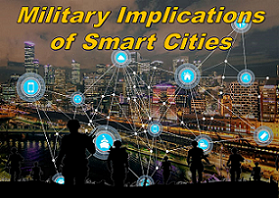[Editor’s Note: Today’s post by guest blogger Alexander Braszko, Jr. was the second runner-up in our recent Mad Scientist Operational Environment in 2035 Writing Contest. Mr. Braszko’s post is especially relevant, given the following comment by LTG Theodore D. Martin, Deputy Commanding General, U.S. Army Training and Doctrine Command (TRADOC) from TP 525-92-1, The Changing Character of Warfare: The Urban Operational Environment: “The U.S. Army faces numerous challenges in our current and near-term future operational environments. None will be more difficult than conducting operations in the world’s urban areas.” Mr. Braszko describes how technology will continue to permeate through the infrastructure of Smart Cities and addresses its specific military implications, the opportunities and vulnerabilities, through all phases of operations, across all warfighting functions — Enjoy!]
“In the future, I can say with very high degree of confidence, the American Army is probably going to be fighting in urban areas.”1 General Mark Milley

While senior military leaders today understand the value of assessing the operational environment through the lens of Multi-Domain Operations (MDO), the integration of data and technologies into citywide operations, oftentimes referred to as “Smart City” initiatives, remains underappreciated. Military planners need to discover how extensively technology is linked to municipal operations, including emergency operations centers, common operational picture platforms, and city dashboards. Failing to conduct thorough Joint Intelligence Preparation of the Operational Environment (JIPOE) that includes Smart City systems and networks will prove detrimental to any modern military attempting to dominate a city’s area of influence. This is especially true if that military has no intention of demolishing and rebuilding a digital city’s infrastructure from scratch.
Tracking global Smart City growth and trends is worthwhile for all Joint members, across all domains, especially as the numbers and sizes of cities continue to grow in the future. Understanding today’s Smart Cities results in improved situational awareness, better operational assessments, enhanced targeting actions, and more effective execution of influence operations. Developing Joint operational means to collect adversary municipal data and exploit emerging Smart City technologies will prove critical in fighting peer threats in future urban environments. Conversely, understanding our own Smart City efforts and vulnerabilities in the United States is critical for successfully defending our homeland and military installations.
The Continued Growth of Smart Cities

The near-term future promises an explosion in both the number and the percentage of the world’s population living in urban areas. There are currently 29 cities in the world with a population of more than 10 million people. That number is expected to climb to 43 by 2030.2 According to the World Water Council, by 2030, 70% of the world’s population will live in cities.3 Municipal governments are well aware of these facts. On the whole, they are trying to accommodate that growth and continue to provide traditional city services. One more recently popular way, especially for cities with robust resources, is through the collection of data and the integration of technologies for improved quality of life, improved sustainability, and greater efficiencies in municipal operations. This collection of data for decision making and integration of tech and sensors into municipal operations is commonly referred to as being a “Smart City”.
Larger municipalities, such as New York, Paris, and Shanghai have grown familiar with the value of accumulating large data sets and digitized information. Many cities have created positions to deal with the large data sets and the integration of emerging technologies: Chief Data Officers, Chief Technology Officers, and Chief Innovation/Information Officers, for example. CDOs, CTOs and CIOs are  grappling with how best to use newly acquired data to improve municipal processes, how to share data over Internet of Things (IoT) networks, and how to best store it.4 Additionally, the most prudent cities are attempting to secure multiple IoT networks outside traditional city networks from cyber attacks, but those that do so are rare.
grappling with how best to use newly acquired data to improve municipal processes, how to share data over Internet of Things (IoT) networks, and how to best store it.4 Additionally, the most prudent cities are attempting to secure multiple IoT networks outside traditional city networks from cyber attacks, but those that do so are rare.
Smart City and Smart Technology Defined
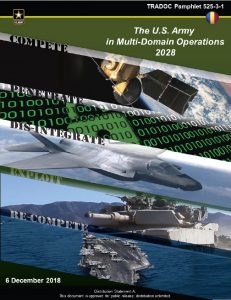 While the term MDO can be challenging to explain, the term Smart City is somewhat more difficult to comprehend, in part because of the lack of a clearly accepted definition of the term and in part due to multiple facets of Smart City initiatives. A doctrinal definition of Smart City and associated terms is essential in order to facilitate MDO in urban environments. For the purposes of this article, a Smart City is an urban area with municipal government leaders who use technologies, including cameras, sensors, and IoT networks, to collect data for improved municipal decision making. Collected data can be used by various departments (e.g.,
While the term MDO can be challenging to explain, the term Smart City is somewhat more difficult to comprehend, in part because of the lack of a clearly accepted definition of the term and in part due to multiple facets of Smart City initiatives. A doctrinal definition of Smart City and associated terms is essential in order to facilitate MDO in urban environments. For the purposes of this article, a Smart City is an urban area with municipal government leaders who use technologies, including cameras, sensors, and IoT networks, to collect data for improved municipal decision making. Collected data can be used by various departments (e.g.,  Water, Public Works, General Services, Information Technology, Health, Police, and Fire) to improve citizens’ quality of life and present ways to analyze efficiencies in citywide operations.5
Water, Public Works, General Services, Information Technology, Health, Police, and Fire) to improve citizens’ quality of life and present ways to analyze efficiencies in citywide operations.5
While most technologies are not necessarily labeled a Smart Technology, if used for municipal government operations, many can and often do fall under the category. Autonomous vehicles, sewer sensors, traffic management, and road construction technologies can all fall into the Smart Technology context, again as they are used by cities to conduct day to day operations. The spectrum of technologies that fall under Smart City initiatives is broad, to say the least.
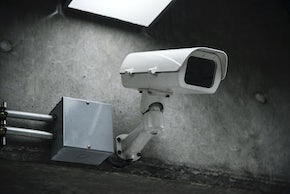
When City Hall leadership appreciates technology and invests in integrating technologies into citywide operations, improvements typically follow: road repair times decrease, streets do not flood as frequently, and garbage is picked up on time. Thanks to improved understandings of, and use of, big data, IoT networks, and Smart City technology integration, efficiencies in Water Departments, Public Work Departments, and Police Departments are constantly improving. Cities are regularly making headlines and winning awards sponsored by companies and corporations with a stake in the Smart City wave, such as Bloomberg Philanthropies, Cities Today, Fira Barcelona, and others.
The urban environment, specifically with respect to Smart City technologies and networks, is the ideal environment to create and integrate effects across all domains…
Why Should the Department of Defense (DoD) Care?
Cities of the future will undoubtedly continue to conduct operations in digital environments. The myriad connected sensors, vehicles, and IoT systems that Smart Cities possess make up an important portion of the Operational Environment (OE) of the future. Equally important to remember, a city’s data collections occur in multiple domains: cyber, space, and the electromagnetic spectrum, and operations in those domains will become much more commonplace over time. The urban environment, specifically with respect to Smart City technologies and networks, is the ideal environment to create and integrate effects across all domains, both prior to conflict and during kinetic targeting in large-scale combat operations (LSCO).  It is crucial for military planners to capitalize on potential access points within adversary nations’ infrastructure; maneuvering under, through, or over cities with robust integrated sensors. Smart City technologies and sensors will prove risky to US and friendly forces if those systems are not adequately mapped and controlled.
It is crucial for military planners to capitalize on potential access points within adversary nations’ infrastructure; maneuvering under, through, or over cities with robust integrated sensors. Smart City technologies and sensors will prove risky to US and friendly forces if those systems are not adequately mapped and controlled.
Moreover, failing to understand and mitigate our own cities’ exploitable Smart City infrastructures puts the United States at risk of similar efforts by advanced adversaries in future LSCO. The DoD, too, needs to partner with DHS and the FBI as it works to create Smart Installations in order to recognize and protect identified vulnerabilities. Looking to experienced Smart Cities’ lessons learned securing IoT networks would be prudent.
Better understanding Smart Cities will result in improved situational awareness, enhanced operational assessments, and identification of opportunities for targeting and executing influence operations.
Specific Military Implications of Smart Cities
Smart City technologies offer opportunities and vulnerabilities, through all phases of operations, across all warfighting functions. The use of Smart City technologies for exploitation and collection is critical for modern military operations; they can be especially useful when those technologies are unprotected outside of a city’s firewalls. All that is required to exploit these technologies are moderately tech savvy entities possessing some nefarious creativity. The military can exploit Smart City technologies through Denied Access and Detection, Situational Awareness and Messaging, Maneuver, Cyberspace Operations, and Space Operations.

Denied Access and Detection. Smart City technologies create new and unfamiliar obstacles for military planners. For example, planners should consider counter-drone systems used in airports or in stadiums and should seek to discover impacts to military autonomous drones or precision weapons systems. As businesses use drones to deliver packages and citizens use them for recreational activities, cities will be forced to develop drone identification systems, along the lines of beacons or RFID tags. Drones that operate without such identifiable features are likely to be noticed and face possible fines or police response. System and capability developers should decide if their future military drone systems incorporate such identification systems. Additionally, with facial recognition software and AI used to detect anomalies by drones in public crowds, police departments and emergency responders can now better identify and track criminals, which makes going unnoticed in a city much more difficult today. For surgical operations, planners need to consider best practices to avoid detection by military drones and conceal friendly drone activities.
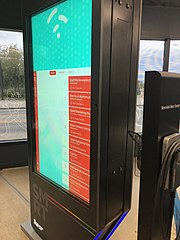
Situational Awareness and Messaging. Through Smart City technologies, military forces can gain access to municipal Common Operating Pictures (COPs) for improved situational awareness.6 COPs are often very expensive and cost-prohibitive for all but the better resourced cities. However, Smart City kiosks are becoming more popular even in midsized cities. Kiosks first appeared in the US in New York City. Early on in implementation, their effectiveness was limited at best, but multiple iterations later they are now providing access to information within a local geographic area. Everything from special events, entertainment options, restaurants’ table wait times, public transpiration schedules, and delays can be accessed through Smart Kiosks. Many kiosks have cameras integrated with their interactive platforms and have an ability to record the areas around them. Kiosk providers are promising that future systems will likely include AI and interactive voice services to improve customer interaction. Messaging through kiosks throughout a city is possible, and done today for advertising and emergency management reasons. Additionally, in China, health officials are using drones to deliver verbal messages and warnings to motivate individuals to take health precautions during the ongoing coronavirus crisis. Smart City technologies should be considered for providing local access for improved situational awareness and messaging capabilities.
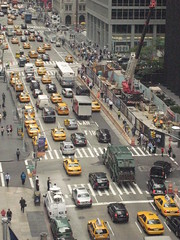
Maneuver. Cities regularly use traffic management sensors capable of distinguishing between individuals, scooters, bikes, cars or buses. Collection of such data helps a city to understand traffic flow, respond to incidents, and predict traffic patterns, given times and various weather scenarios, along with the likelihood of traffic jams or flooded roads in a city. Traffic lights are often tied to those systems for greater efficiency during rush hour to prevent traffic jams. In megacities or dense urban terrain, one traffic accident can cause hours of blocked arteries and create choke points for traffic. Such blockages can have significant impact on friendly forces’ maneuverability through a city. Manipulating traffic management sensors provides military forces a means to control people and vehicle flows. Such control might prove worthwhile in the deliberate evacuation of a city, for example, or tracking a population’s exodus during a crisis.
 Cyberspace Operations. Many Smart Cities freely share data as a part of data transparency requirements, but do not fully appreciate how that data may be analyzed and exploited by tech savvy adversaries. Some cities even provide public access to their data platforms and dashboards. Of course, most cities are more concerned about personally identifiable information exposure than OPSEC considerations. In Smart Buildings, hackers have shown an ability to hijack smart doors and building access control systems and use them to launch Distributed Denial-of-Service attacks.7 Very few cities actually invest in or budget for securing all of their IoT networks or sensors and both the electromagnetic spectrum portion and software portions of IoT systems can be exploited. Understanding citywide IoT networks is crucial for successfully employing cross-domain fires and understanding how city governments execute command and control during a crisis. Protecting our own smart and connected IoT and Smart systems is critical to prevent similar attacks by adversaries.
Cyberspace Operations. Many Smart Cities freely share data as a part of data transparency requirements, but do not fully appreciate how that data may be analyzed and exploited by tech savvy adversaries. Some cities even provide public access to their data platforms and dashboards. Of course, most cities are more concerned about personally identifiable information exposure than OPSEC considerations. In Smart Buildings, hackers have shown an ability to hijack smart doors and building access control systems and use them to launch Distributed Denial-of-Service attacks.7 Very few cities actually invest in or budget for securing all of their IoT networks or sensors and both the electromagnetic spectrum portion and software portions of IoT systems can be exploited. Understanding citywide IoT networks is crucial for successfully employing cross-domain fires and understanding how city governments execute command and control during a crisis. Protecting our own smart and connected IoT and Smart systems is critical to prevent similar attacks by adversaries.
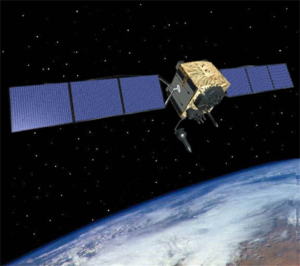 Space Operations. Space-based services are beginning to appear in municipal operations. Cities use Geographic Information Services (GIS) and geospatial products, including overhead imagery, in planning and executing municipal projects. Companies, like Planet Labs, sell decades of global archived imagery data, at resolutions sufficient for many city planners, providing data for improved decision making. Often more timely than traditional airplane photography, space-based imagery is now being shared between departments in larger cities. On-order tasking can occur in as little as 24-48 hours.8 Denying an adversary access to such imagery is essential for OPSEC of friendly forces.
Space Operations. Space-based services are beginning to appear in municipal operations. Cities use Geographic Information Services (GIS) and geospatial products, including overhead imagery, in planning and executing municipal projects. Companies, like Planet Labs, sell decades of global archived imagery data, at resolutions sufficient for many city planners, providing data for improved decision making. Often more timely than traditional airplane photography, space-based imagery is now being shared between departments in larger cities. On-order tasking can occur in as little as 24-48 hours.8 Denying an adversary access to such imagery is essential for OPSEC of friendly forces.
Addressing Smart Cities in Doctrine and Training

As a part of the future OE, the Department of Defense needs to pay closer attention to changes in the urban environment, specifically tracking developments in Smart City initiatives. The DoD should seriously consider addressing Smart City terminology in doctrine. It needs to codify Smart City technologies present in cities. It also needs to train forces to exploit Smart City technologies across multiple domains. It needs to do these things if it hopes to fight and win future wars against technologically competent peer adversaries in urban environments.
The aforementioned exploitation methods and Smart City technologies offer a small glimpse into the military implications of today’s Smart Cities. Understanding how extensively those technologies are linked to operations in municipal government services, how they are impacting lives in cities, and how friendly and adversary forces alike can exploit those Smart systems is crucial for US forces to be effective in future MDO.
If you enjoyed this post, check out:
Smart Cities and Installations of the Future: Challenges and Opportunities
Base in a Box by Lewis Jones
Top Ten Takeaways from the Installations of the Future Conference
Army Installations: A Whole Flock of Pink Flamingos by Dr. Jason R. Dorvee, Mr. Richard G. Kidd IV, and Mr. John R. Thompson.
>>> REMINDER 1: Mad Scientist wants your Information Warfare Vignettes! We launched this crowdsourcing exercise to complement our Weaponized Information Virtual Events and we want to hear from you! Review submission guidelines on our flyer here, then craft and submit your most innovative and insightful visions of information warfare to us at: MADSCITRADOC@gmail.com. The winner of our writing contest will be present at our virtual conference on 21 July 2020. Deadline for submission is 1 July 2020!
 >>> REMINDER 2: The Mad Scientist Initiative will facilitate the fourth webinar in our Weaponized Information Virtual Events series two weeks from now, on Wednesday, 17 June 2020:
>>> REMINDER 2: The Mad Scientist Initiative will facilitate the fourth webinar in our Weaponized Information Virtual Events series two weeks from now, on Wednesday, 17 June 2020:
-
- How ISIS uses Social Media in Saudi Arabia and The Effects of De-platforming Bad Actors, presented by Georgetown University Student Panels
Stay tuned to the Mad Scientist Laboratory — we will open registration one week prior to this event!
>>> REMINDER 3: If you missed the first three webinars in our Mad Scientist Weaponized Information Virtual Events series — no worries! You can watch them again here, here, and here [via a non-DoD network].
Alexander Braszko, Jr., served for 22 years in the US Army as a Military Intelligence and Space Operations Officer, integrating Space, Cyber, EW and IO effects into operations. He is a graduate of the US Military Academy at West Point and a Graduate of the Naval Postgraduate School with a MS in Space Systems Operations Management.
Alexander served as Chief Innovation Officer (CIO), Kansas City, MO after his retirement from the Army under Mayor Sly James, Mayor Quinton Lucas, and City Manager Troy Schulte. During his time as CIO, Alex coordinated pilots with Planet Labs and Space X’s Starlink. Additionally, he led efforts in developing KCMO’s Smart City Action Plan and passage of Resolution 190838, the Creation of an Emerging Technology Board. He currently works at the Center for Army Lessons Learned (CALL) as a Military Analyst on Fort Leavenworth, KS.
Disclaimer: The views expressed in this blog post are solely those of the authors and do not necessarily reflect those of the Department of Defense, U.S. Special Operations Command, Department of the Army, Army Futures Command, or the Training and Doctrine Command.
1 https://www.armytimes.com/opinion/commentary/2018/07/20/commentary-the-missing-link-to-preparing-for-military-operations-in-megacities-and-dense-urban-areas/
2 https://www.un.org/development/desa/en/news/population/2018-revision-of-world-urbanization-prospects.html
3 https://www.uclg.org/sites/default/files/final_press_release_major_city_networks_en.pdf
4 https://iot.ieee.org/images/files/pdf/IEEE_IoT_Towards_Definition_Internet_of_Things_Revision1_27MAY15.pdf
5 https://www.govtech.com/fs/What-Is-a-Smart-City.html
6 https://www.govtech.com/fs/What-Is-a-Smart-City.html
7 https://www.technadu.com/hackers-break-into-smart-buildings-launch-ddos-attacks/91404/

